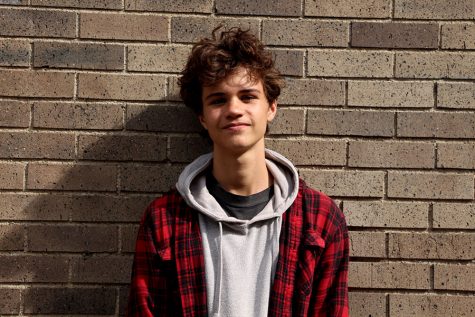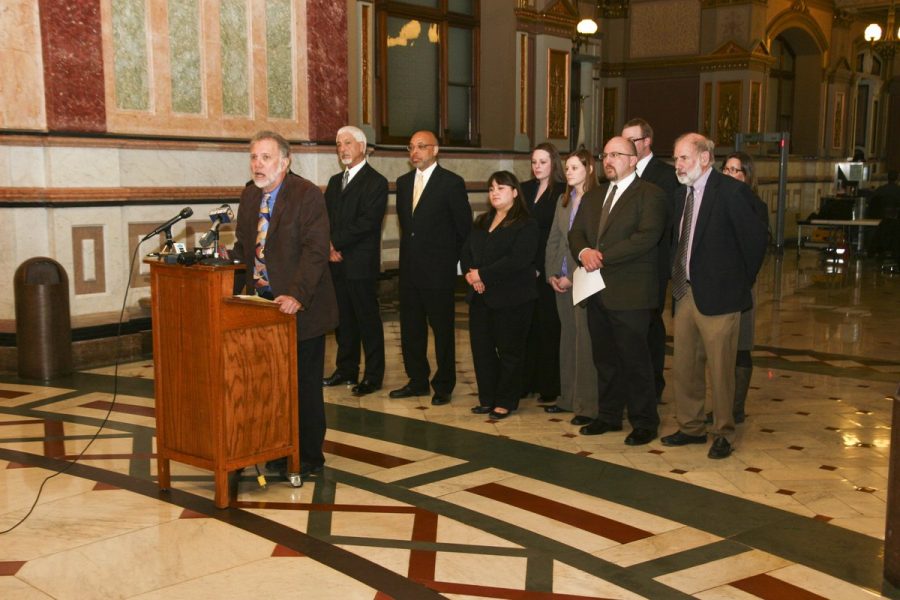Wrongful incarcerations leave impacts far beyond bars
Photo Courtesy of the Illinois Innocence Project
South High Special Education teacher S.T. Jamison, pictured second from the left in the back, fought for his Uncle’s exoneration. Wrongfully incarcerated for a crime he didn’t commit Grover Thompson spent the rest of his life in prison. Thompson was finally exonerated on January 14th through the work of his uncle, South teacher S.T. Jamison.
“It’s a tragedy, it truly is. I wish he were alive today, I wish I could go back and undo the pain and suffering, the mental anguish that he must have been experiencing in prison. It’s one thing to be in prison if you are guilty, but it’s a whole ‘nother thing to be in prison if you know you didn’t do something,” said Special Education teacher S.T. Jamison of his uncle, Grover Thompson, a Illinois man wrongfully convicted and imprisoned for attempted murder.
In 1981, Thompson was a homeless man travelling to see family in Mississippi. Between buses, Thompson took shelter to rest in a post office in Mount Vernon, Illinois. While he was asleep, an elderly woman was attacked in her apartment by the serial killer Timothy Krajcir, who then fled the scene of the crime by leaping five feet to escape through a window.
Police searched for the assailant, described as a Black male, and encountered Thompson. He was misidentified as the perpetrator and taken into custody to be part of a one-man line-up, an illegal practice when witnesses only have one suspect to identify as the criminal.
In the courtroom, injustice continued: “What my uncle’s defense attorney was able to do, he was able to show physically that my uncle was not able to [commit the crime]… To escape, [the murderer] had to jump up 4-6 feet,” said Jamison. Thomson suffered from a disabled leg making him unable to easily walk, much less jump five feet in the air. Although it was demonstrated that Thompson physically could not have committed the crime, the judge did not permit that evidence to be recorded in court.
Given 40 years in prison, Thompson spent the next 15 years of his life behind bars until dying in prison for a crime he did not commit.
“You don’t have any physical evidence linking [him to the crime]. There are assumptions being made, there are some underlying prejudicial assumptions. People are making broad leaps to convict him,” Jamison said.
Then Jamison was contacted by the Illinois Innocence Project. According to their website, “The Illinois Innocence Project (IIP) is dedicated to freeing innocent men and women imprisoned in Illinois for crimes they did not commit. We advocate on behalf of this silenced population by researching and investigating claims of innocence, and providing legal representation and other assistance to prove credible claims of actual innocence.”
With the aid of the IIP, Jamison presented their case for Thompson’s innocence to the Illinois Criminal Review Board but were turned away. Even though the real perpetrator who was apprehended in 2007 for a different murder confessed, the state refused to acknowledge Thompson’s Innocence.
Moving to pressure the Governor, Jamison and the IIP’s work began to gain the attention of the local media. Through the terms of two different governors, they petitioned unsuccessfully until the unabating pressure reached a boiling point. “The powers that be, the Governor’s office and the political powers that be became aware that this case was not going away,” said Jamison.
Through this constant pressure, Thompson was finally exonerated this January. After 37 years, he was legally declared innocent by the State of Illinois.
“They did not want to admit that the criminal judicial system made a huge mistake. That they arrested a man, convicted him solely on the basis of misinformation, false eyewitness account. They did not want to admit that there were some sinister motivations behind it,” said Jamison.
The impacts of incarceration are profound. Jamison said, “You’re taking the blame for a heinous crime. Imagine if you were charged for trying to stab a old lady… If you imagine having that charge against you and maybe having your own family think ‘Oh God did you do that?’”
To Jamison, the resolution of his efforts is still complex: “It’s bittersweet, it’s a bittersweet story and ending. But thank God his name is clear, that he did not commit that crime.”
“Anytime that things are subjective, anytime that we’re looking at witness statements and we’re not getting that hard evidence, it opens itself up to prejudice,” said Equity and Diversity Coordinator Alex Endeshaw. “When you have subjectivity that lends itself to prejudice, that will in turn feed institutional racism.”
Grover’s story is far from unique, people of color are disproportionately present in prisons across the country. A massive portion of these incarcerations are the results of non-violent drug charges. According to the Hamilton Project, although the rates of drug consumption are roughly equal between Black people and white people, Black people are 6.5 time more likely to be incarcerated for drug-related crimes.
Coupled with these immense racial disparities, are also intersections of classism. The incarcerated disproportionately consist of citizens in the lower class. “Police officers don’t arrest nor does the system convict rich people…they don’t get the same kinds of punishment that poor people get,” said Jamison.
Felonies continue as a method of further disenfranchising already marginalized groups. Particularly for non-violent drug offenses, Endeshaw believes non-violent drug felonies have no place: “What we decide as felonious comes from what…the society’s moral compass is based on.” He continued: “Laws are felonius when they are beyond a certain level based on what our society’s value system says is moral. So how are we so far beyond our value system where we are felonius… when such a large portion of our population partakes in the activities that we are saying are felonius?”
“It makes absolutely no sense that drug charges are felonius…The empiricism behind who does drugs and who does what drugs shows that according to American values, we have no problem with drugs,” Endeshaw said.
According to the NAACP, “Between 1980 and 2015, the number of people incarcerated in America increased from roughly 500,000 to over 2.2 million.”
Jamison sees the increasing trend of mass incarceration as a transition from the days of Jim Crow: a time he is all too familiar with. Born on a sharecropping plantation in Mississippi, Jamison has experienced the post-Reconstruction impacts of it, calling it “a different kind of slavery.”
With sharecropping, white plantation owners would lease land, equipment, machines, and seed to African Americans who would farm the land. More often than not, the debt owed to the plantation owners would be more than profits of the harvest, keeping African Americans entrapped in a perpetuating system.
“That’s the way the plantation owner essentially owned you, it wasn’t legal slavery but it was quasi slavery. So I was born into that system…It was a system of violence. It was maintained through segregation and violence,” said Jamison.
Growing up in the Jim Crow era, Jamison turned to education as a means to fight the economic deprivation around him. “Education means so much to me. It’s power, it opens doors, it’s a way out, and it’s a way to break the cycle of poverty.”
Obtaining a college education was no small feat for him. In a time where it was not uncommon for African Americans to only receive four months of school to a white person’s traditional nine, Jamison fought for his education.
“When I started school in 1961, there were only two libraries in the state of Mississippi for Blacks,” he said. “They were making sure that Black people did not read. That they did not get an education.”
To Jamison, “Education really is the only way out for the poor. There is no other way out because you don’t have the assets, you don’t have the capital, you don’t have the inheritance that other people have.”
The systematic efforts to suppress the education of marginalized communities is far from a thing of the past. Today Minnesota has one of the largest achievement gaps in the nation according to the National Assessment of Educational Progress.
According to Endeshaw, the ideas around education need to be reframed across the board, “People need to see the work in [education]… [even] kids that are culturally at what all of this pedagogy was designed for, they are the people that all of this was designed for, even these students don’t see the value of what we’re doing.”
However, societal, institutional, and economic systems are to blame for the disparities in education, not the students. “There are people that have never seen over 10 miles away from their home. So how can you even understand the capabilities and the possibilities that you have as a human being. Especially then when… people think that you are lesser.”
To Endeshaw, a huge factor in these disparities is representation, “We tell people that education is power but we never show anybody that… representation is massive, it’s huge. I almost cried watching Black Panther… I almost cried watching Into the Spider Verse as well because when I was a kid that wasn’t there… Latching on to who I can be, it seems really simple that you could look out and be whoever you want but when they truly don’t look like you it’s hard.”
This also includes in-school role models like Endeshaw and Jamison. “We need more Black excellence, we need more Native excellence, we need more Latinx excellence put on display, put at the forefront and then we need white folks to take a step back and just breathe,” said Endeshaw.

Henry Holcomb is a senior at South and is the Features Editor for the Southerner. In his third year on the Southerner, Holcomb is excited to be involved...

